Public Art Highlights for 2023
UAP's curatorial team, alongside esteemed contributing curators, handpicked the standout public art projects of the year.
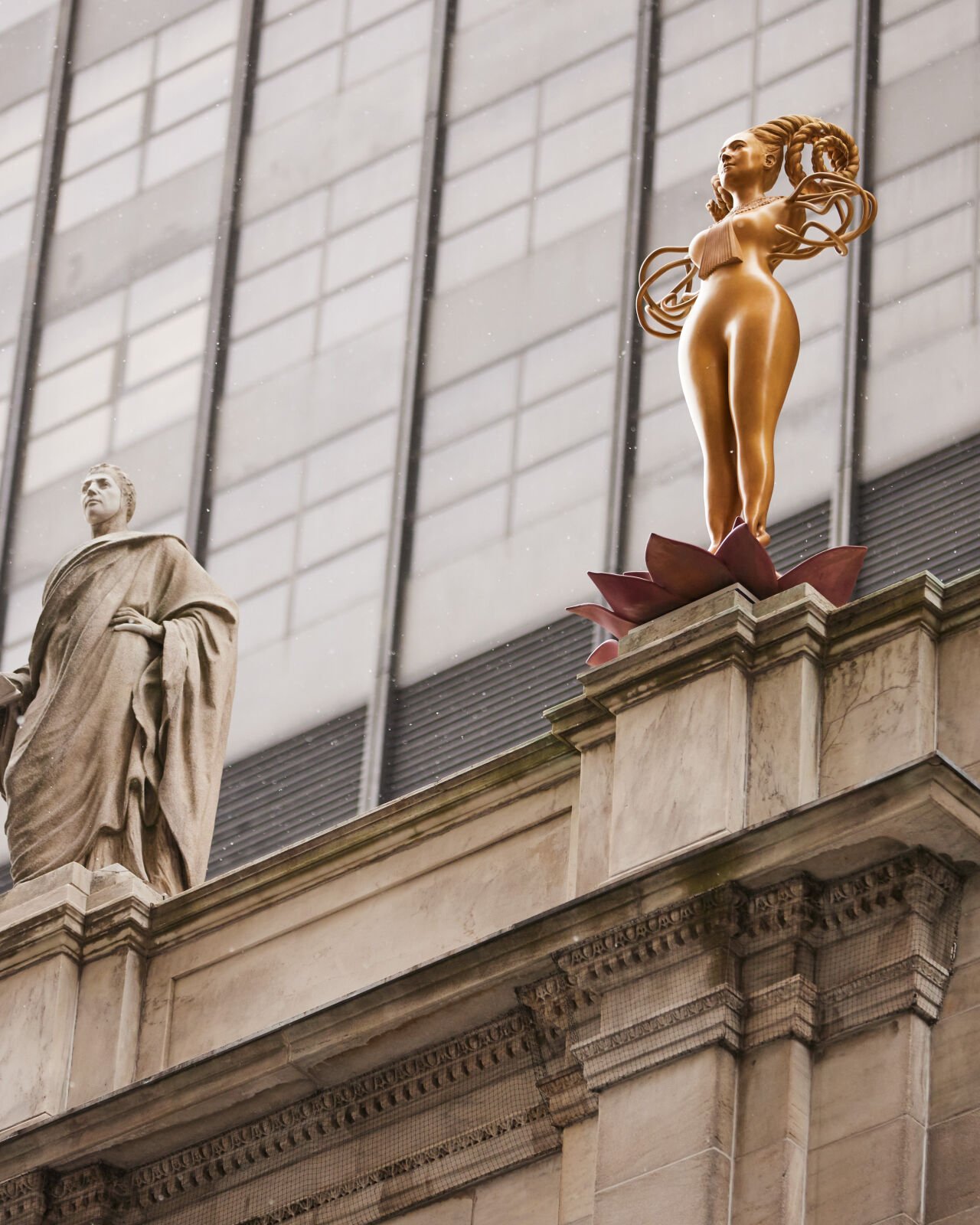
UAP is thrilled to unveil the standout achievements in public art with this year's Best of Public Art showcase. In a year brimming with visionary and timely projects, we've witnessed a profound exploration of the public engagement and connection, a dynamic expression of voices, and a powerful unification of communities and ideas through the transformative medium of public art.
UAP's Director | Curatorial Natasha Smith and Curator Anna Bellotti have partnered with internationally recognised curators to reflect on the stand-out public art projects of 2023. The contributing curators this year are Dina Amin, curator and CEO of the Visual Arts Commission; Tairone Bastien, an independent curator based in Toronto and an Assistant Professor in the Criticism and Curatorial Practice program at Ontario College of Art and Design University; Hedwig Fijen, Founding Director of Manifesta; Nora Lawrence, Artistic Director and Chief Curator of Storm King Art Center and Nathan Pōhio (Waitaha, Kāti Mamoe, Kāi Tahu, Ngāti Kahungunu, Tau Iwi), artist and Senior Curator Māori at Auckland Art Gallery Toi o Tāmaki, a founding member of Paemanu and Co-Vice President of Te Ūaka Lyttleton Museum.
According to Natasha Smith, “This year's selection – with thanks to our esteemed contributors – is incredibly sensitive, beautiful and of the ‘now’. Themes centre on revealing truths; truths about places, histories, cultural erasure, sexual and racial inequality, and war. However, all is not lost, light is also a theme that shines through as a call to undertake restorative discourses that enable shared learnings. It is certainly a thought-provoking collection of incredible public artworks for 2023.”
Best of Public Art 2023: Full Project List with Commentary from Curators
Dina Amin
- Shahzia Sikander | NOW, New York, USA
Towering above the hustle and bustle of mid-town Manhattan stands NOW by artist Shahzia Sikander, a Pakistani American artist celebrated globally through her many participations in global exhibitions and is often known for her engagement with miniature painting. What is remarkable about this work is both its physical manifestation and its symbolism. Installed by Sikander atop the imposing rooftop of the New York State Supreme Court on Madison Avenue, NOW rises from the base of a vacant lotus plant and is the first female sculpture to join a line-up of traditional stone-carved robed male figures long employed to represent the greatest imparters of law throughout time including Confucius, Justinian and others. At a larger-than-life 8ft, this gold metal-coloured triumphant female sculpture is an important response to the NOW and the times in which we live, which, in other words, is the cultural reinvestigation that is taking place in New York and globally as we consider our past, our present and our future. As we look to reposition long-held views on gender and the biases that exist around the role of women in our societies, power, race and the importance of celebrating the diversity of the peoples that make up our societies, now is the time for NOW.

Photo by Lynda Churilla. Courtesy of the artist and Madison Square Park Conservancy.
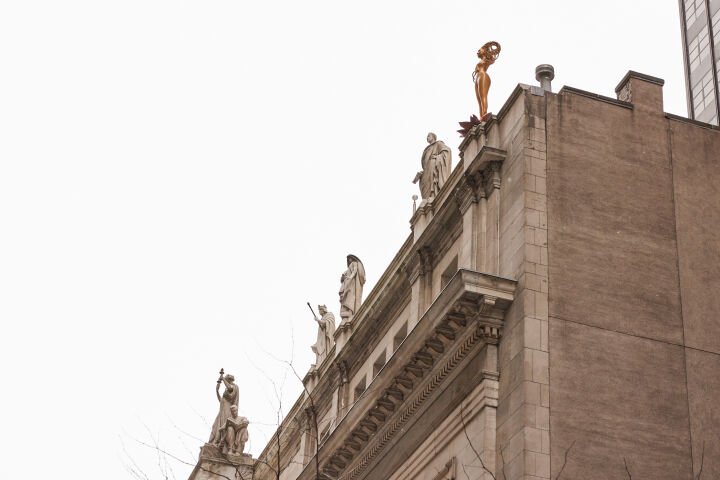
Photo by Lynda Churilla. Courtesy of the artist and Madison Square Park Conservancy.
- Tracey Emin | The Doors, London, UK
After a significant refurbish, the National Portrait Gallery in London reopened in mid 2023 with new monumental bronze doors at its north entrance. These newly installed doors are the work of Tracey Emin, who, through these doors, provides an opportunity to highlight the long-neglected role of women artists within the collections of major institutions worldwide. Consisting of 45 portraits of women on bronze panels making up the three entrance doors, The Doors seeks to represent ALL women rather than capture the likeness of any one woman. Each of the 45 female faces is hand drawn gestural representation of the female face, which were then cast in bronze in the grand tradition of historical engagements with monumental bronze sculptural doors that include the defining project that occupied Auguste Rodin for decades: The Gates of Hell.

Photo by Oliver Hess. Courtesy of the artist and National Portrait Gallery, London, UK.
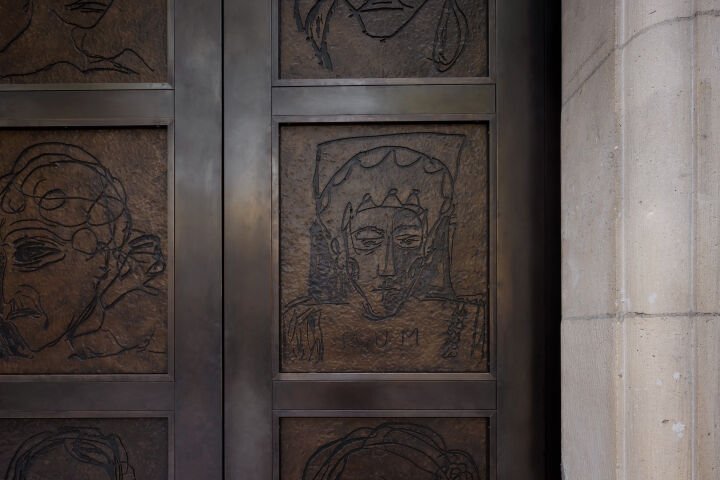
Photo by Oliver Hess. Courtesy of the artist and National Portrait Gallery, London, UK.
Tairone Bastien
- New Red Order | The World's UnFair, New York, USA
One of the most provocative public artworks this year was The World’s UnFair, a surreal fairground full of large-scale sculptures, animatronics, and multi-media installations that overtook an empty lot, primed for development, in Long Island City, Queens. This work is the latest immersive installation by New Red Order (NRO), a public secret society dedicated to creating grounds for Indigenous futures, facilitated by the multi-disciplinary artist Jackson Polys, and the filmmakers and artists Adam Khalil and Zack Khalil.
The World’s UnFair parodies the propagandistic allure and spectacle of World’s Fairs, which gained prominence in the 19th and 20th centuries, with Queens playing host in 1939 and 1964. These events were platforms for promoting industrialisation and global market expansion. NRO’s installation intentionally subverts such fairs’ original purpose by dispelling the myth of Turtle Island as terra nullius before European arrival and exposing the false narratives used to justify genocide and displacement of Indigenous peoples and the theft and capitalistic exploitation of their lands. The site of the installation itself, situated on what is part of the Lenape people’s unceded territory, currently awaits development into yet another glass tower, like dozens of others in the area.
Dismantling entrenched colonial narratives is arduous, yet NRO confronts it head-on by blending wry humour and gravitas to craft their own spectacular world. Here, an anthropomorphic tree and beaver engage in dialogue about private property and its relation to settler colonialism; Jim Fletcher, an accomplice and recurring figure in NRO artworks and events, talks about the desire to perform Indian in videos and posters wheat-pasted across the site; and people who have given Indigenous land back, shared their experiences in a public program, perpetuating knowledge, and tactics for reclaiming and decolonising space.
What makes this work stand apart at a time when public claims to decolonise feel largely performative is that its efforts are more than symbolic. The World’s UnFair is a call to action for restorative justice. The work invites people to become accomplices in the Land Back movement, to donate and support Lenape organisations like Lenni Lenapexkweyok, get informed on the issues, and support all Indigenous people’s right to return to their ancestral lands as concrete steps towards a decolonised future.
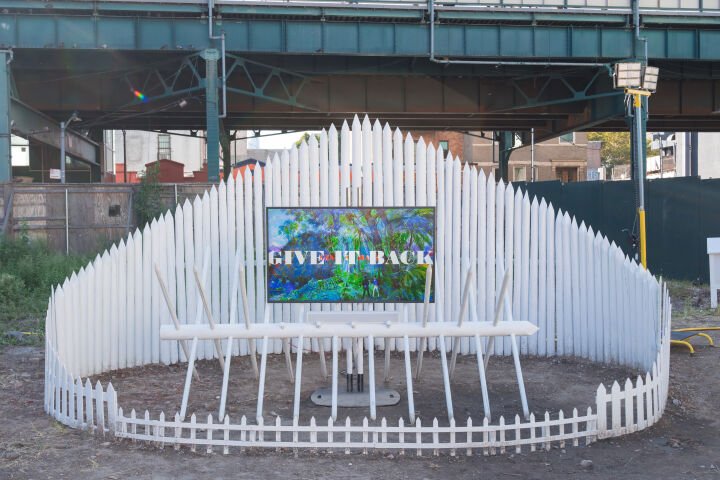
Courtesy of Creative Time. Photos: Cesarin Mateo.
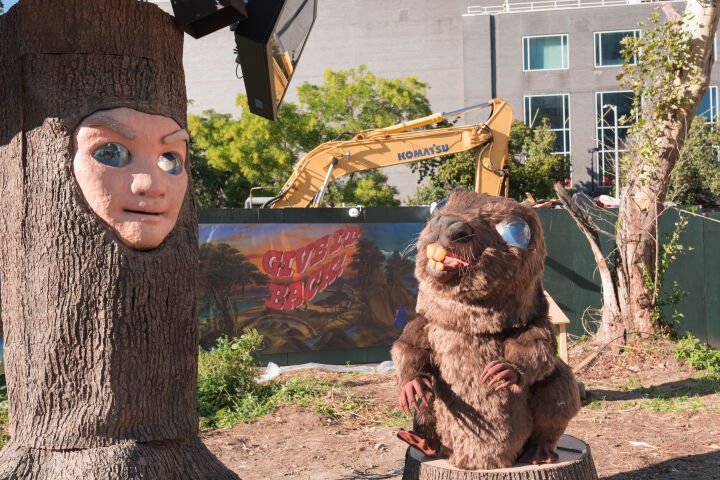
Courtesy of Creative Time. Photos: Cesarin Mateo.
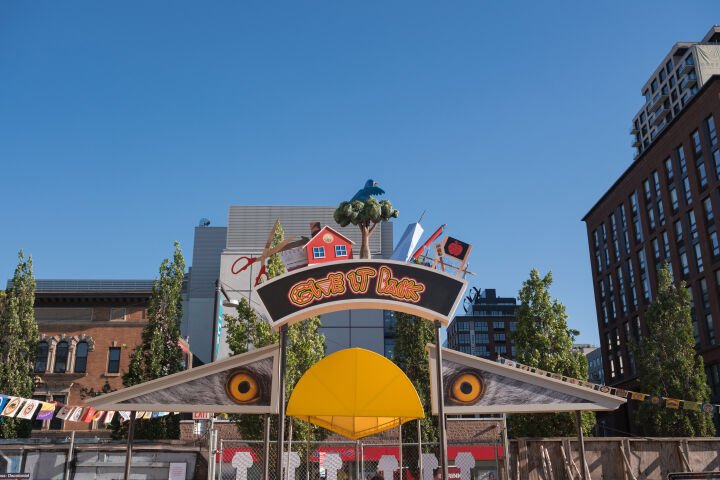
Courtesy of Creative Time. Photos: Cesarin Mateo.
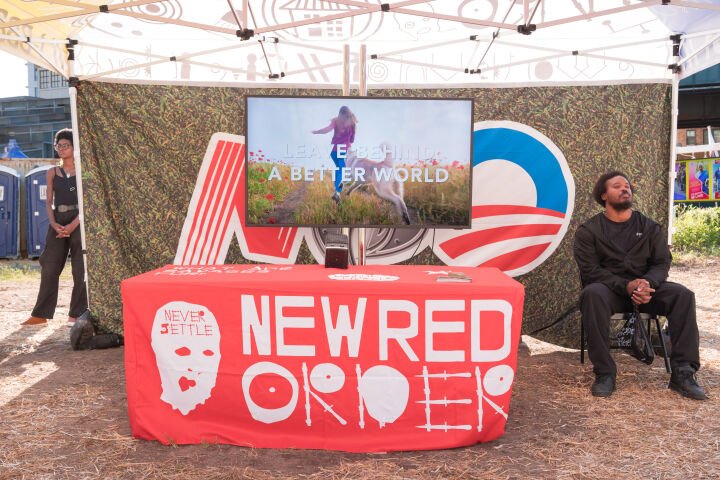
Courtesy of Creative Time. Photos: Cesarin Mateo.
- Lani Maestro | No Pain Like This Body, No Body Like This Pain, Vancouver, Canada
The most incisive public artwork I experienced this year was a text-based installation by Lani Maestro titled No Pain Like This Body, No Body Like This Pain. I encountered the work on a cold, rainy winter night at the Vancouver Art Gallery’s Offsite location in the city’s Financial District. High above me, two red neon signs glowed with the work’s title. The twin phrases gave me pause, piercing the night like a violence that felt out of place with the artwork’s surroundings.
Maestro is well known for minimal yet provocative text-based works that are site responsive, unearthing a place’s resonant histories and narratives. The two brief lines "No pain like this body" and “No body like this pain” poignantly address human suffering, which is a terrifying condition that sharply contrasts with the work’s sterile and muted environment—a business district of characterless hotels, office towers, and high-end boutiques. This is some of the costliest real estate in one of the most expensive cities in the world and is, no doubt, under constant surveillance and policing. There were no other people there that night, let alone bodies that exhibit pain. It’s a dehumanising façade that belies the reality of Vancouver's most vulnerable populations who are marginalised and invisiblised yet inextricably part of the city.
In an essay accompanying the installation, curator Makiko Hara details that the first version of this work was created in 2010 for an exhibition she organised at Centre A, a non-profit public art gallery then located on West Hastings Street in Vancouver’s Downtown East Side. This is a vastly different part of town that faces profound social challenges, with the highest concentration of people experiencing homelessness in the city, along with drug use and mental health issues that were further stressed by COVID-19. The phrases occurred to Maestro as she navigated through the neighborhood, which brought to her mind the title and themes of the Trinidadian/Canadian author Harold Sonny Ladoo’s book No Pain Like This Body. The book, written in 1972, explores colonial suffering and how it is perpetuated from one generation to the next, embedding itself in bodies until it becomes inseparable from one’s psyche and sense of self.
Resituated here, the full power of Maestro’s work is realised in its ability to bridge these two sides of the city, so that the inter-generational pain so evidently on display in one neighbourhood is read atop the other like a palimpsest, revealing their structural and psychic relation—all are part of the same social body. Dispelling the myth of Vancouver, often celebrated for its natural beauty and high standard of living—for some—is vital and hopefully a dynamic way forward for public art in the city
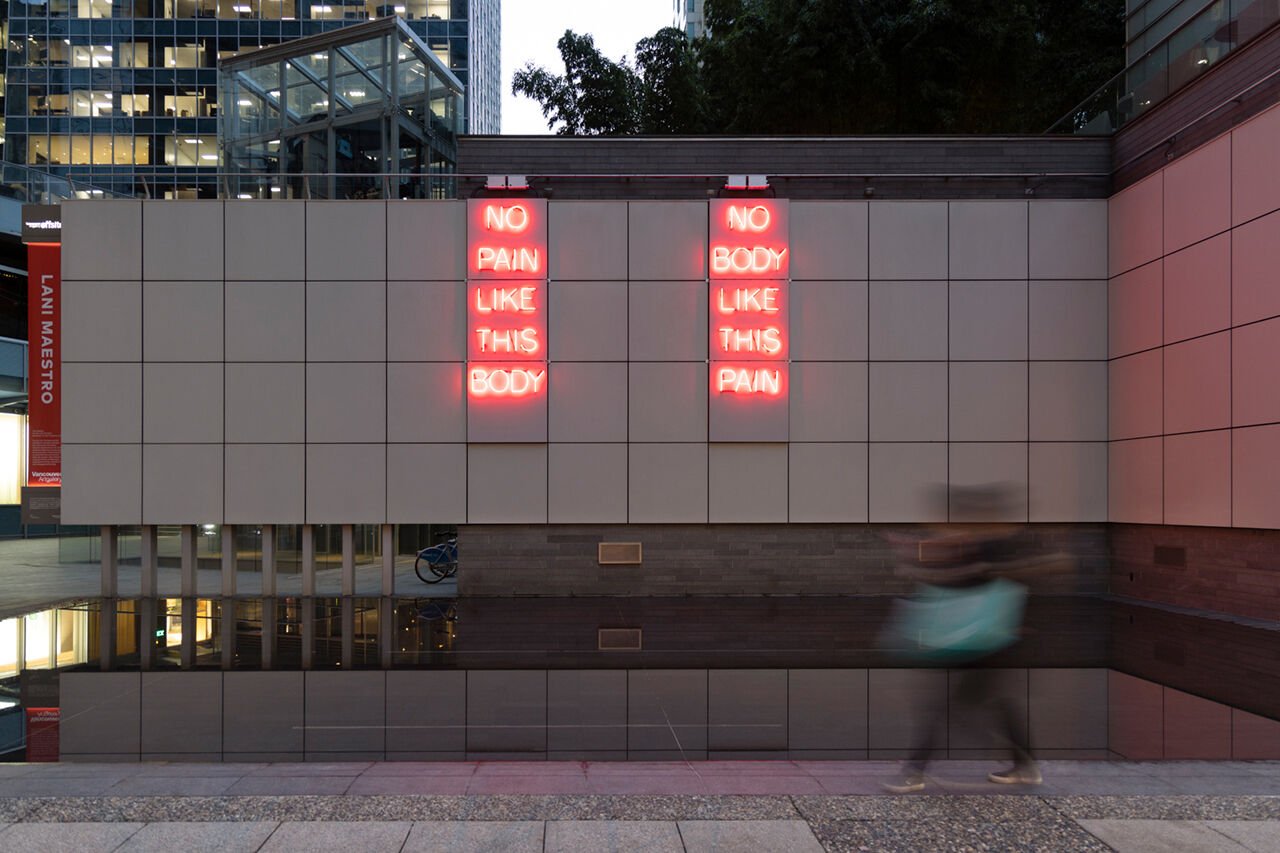
Lani Maestro, No Pain Like This Body, 2022, site specific installation at Vancouver Art Gallery Offsite, Photo Kyla Bailey.
Hedwig Fijen
- Petrit Halilaj | When the sun goes away we paint the sky, Pristina, Kosovo.
In the heart of Prishtina, Kosovo, stands the Grand Hotel Prishtina, a once-grand landmark that has fallen into disrepair. But thanks to artist Petrit Halilaj, the hotel has been transformed into a beacon of hope and possibility with his public art installation, When the sun goes away, we paint the sky.
Halilaj's installation reimagines the hotel's iconic sign, which has been dormant for years. The artist has replaced the missing letters and added new ones, spelling out the words in English and Albanian. The sign now reads: "WHEN THE SUN GOES AWAY, WE PAINT THE SKY."
This poetic message is a call to action for the people of Prishtina to create their own light, even in the darkest times. It is also a reminder of the power of art to transform communities and inspire hope.
In addition to the sign, Halilaj has also remounted and reconfigured the hotel's original stars. He has also invited people from Kosovo to make and display their own stars, adding to the growing constellation that now adorns the building. The stars are free to signify whatever values or desires the people of Kosovo project onto them. Halilaj's public art installation is a powerful and moving work that speaks to the resilience of the human spirit.
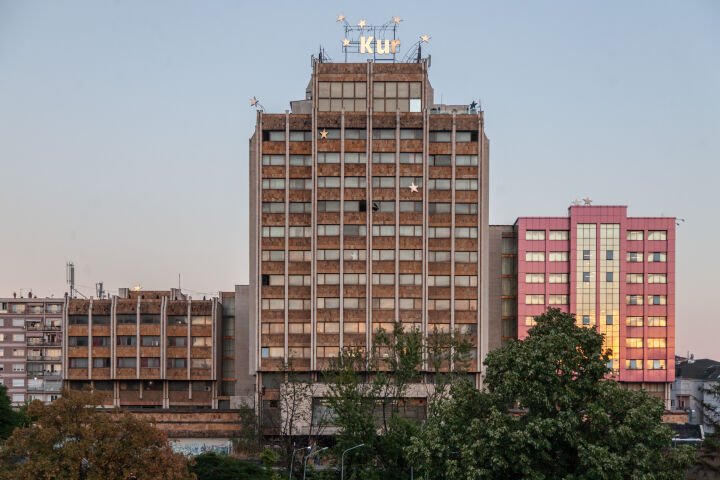
When the sun goes away we paint the sky,2022, © Petrit Halilaj. Photo © Manifesta 14 Prishtina/ Majlinda Hoxha.
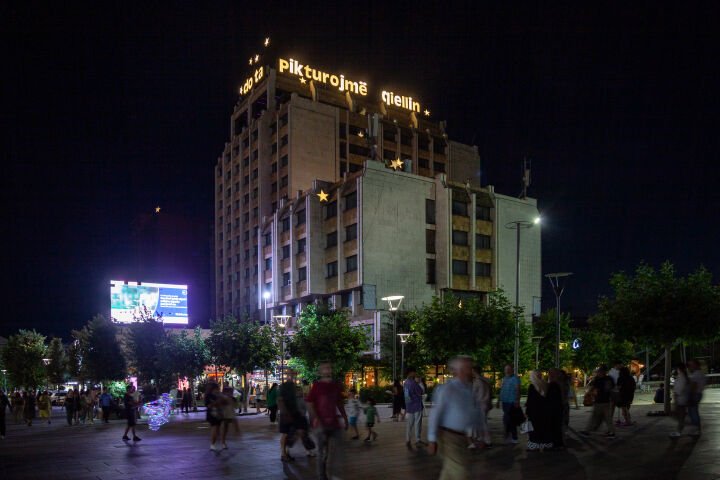
When the sun goes away we paint the sky,2022, © Petrit Halilaj. Photo © Manifesta 14 Prishtina/ Majlinda Hoxha.
- Flaka Haliti | Under the Sun – Explain What Happened, Pristina, Kosovo
Under the Sun – Explain What Happened is a haunting and evocative public art installation by Flaka Haliti that confronts the viewer with the legacy of war and violence. The work consists of a large-scale sculpture made from camouflage netting that has been cut and reassembled into a series of clouds. The clouds are suspended in the air, creating a kind of uncanny horizon.
Haliti created the sculpture using material she found at a former KFOR base in Kosovo. The KFOR is the NATO-led international peacekeeping force deployed to Kosovo in 1999 in the aftermath of the Kosovo War.
The use of camouflage netting in Haliti's work is significant. Camouflage is a military tactic that is used to conceal and deceive. In Haliti's work, camouflage netting is used to create a sense of unease and uncertainty. The clouds are both beautiful and ominous, suggesting that the past is always present, even if it is hidden from view.
The title of the work, Under the Sun – Explain What Happened, is a direct challenge to the viewer to confront the reality of war and its aftermath. The installation invites people to contemplate the historical narratives shaping their identity.
Haliti's work is a powerful reminder that art can be used to bear witness to the past and to challenge us to imagine a better future.
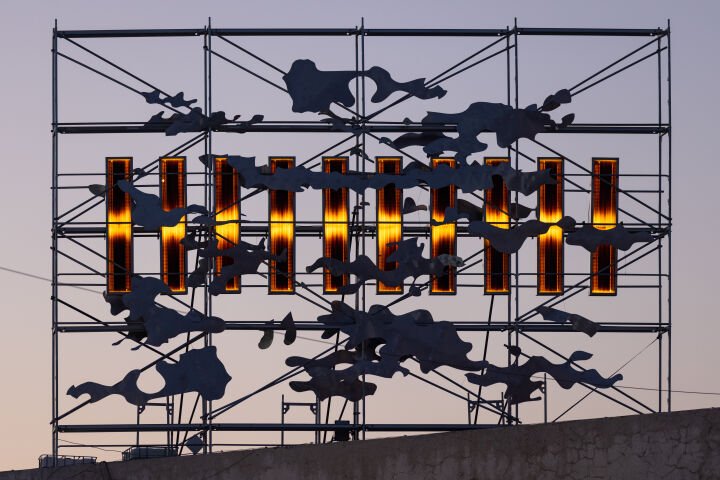
Under the Sun–Explain What Happened, 2022, © Flaka Haliti. Photo © Manifesta 14 Prishtina / Ivan Erofeev.
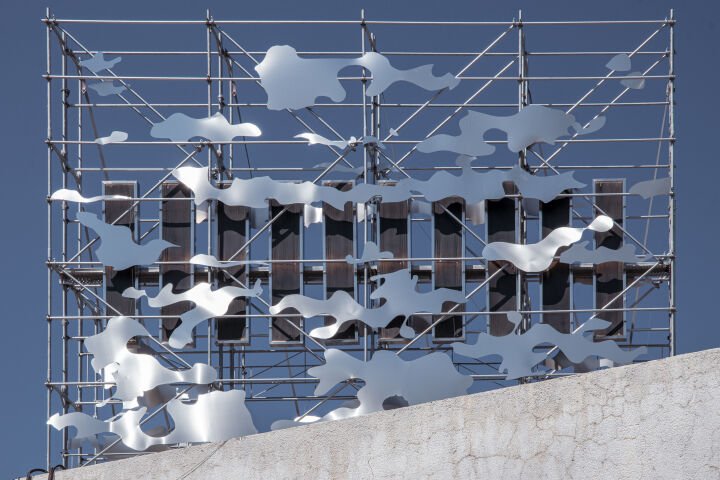
Under the Sun–Explain What Happened, 2022, © Flaka Haliti. Photo © Manifesta 14 Prishtina / Atdhe Mulla.
Nora Lawrence
- Phyllida Barlow | PRANK, New York City, New York, USA
Phyllida Barlow’s exhibition PRANK, in City Hall Park in New York, presented seven sculptures in a series that recalled the very relatable, personal relationship one might have with one’s own objects. The works (with individual titles such as stunt, hoax, jinx, and mimic), although created of steel and fibreglass specifically for this exhibition, appeared as household objects precariously stacked to the best ability of someone, perhaps, too short to do so properly (chucking the top ones overhead with fingers crossed!), or someone careless with possessions belonging to another. The white bunny-like figures atop each sculpture, crafted of fibreglass, add personality, humour, and a calling card of sorts. In the context of City Hall Park, the diagonals, the imbalances, and the specificities of these works really shone through, asking viewers to compare their individuality against the backdrop of the symmetrical, formal architecture of industry and government in every direction. The exhibition was very meaningful to many of us, given Barlow’s unexpected passing just a few months prior to its opening. It was an exceptional, heartfelt goodbye to and commemoration of Barlow, an unconventional and thoughtful powerhouse of 21st-century sculpture.
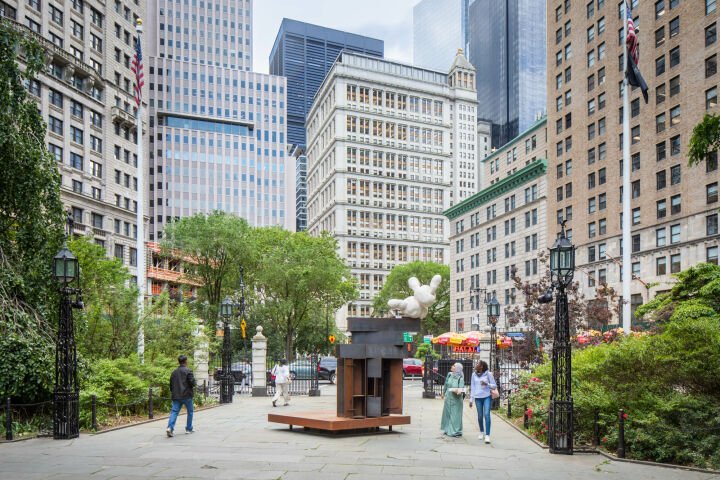
© Phyllida Barlow. Courtesy Hauser & Wirth. Photo: Nicholas Knight, courtesy Public Art Fund, NY. Artwork a part of Phyllida Barlow: PRANK, presented by Public Art Fund in City Hall Park, New York City, June 6, 2023–November 26, 2023.
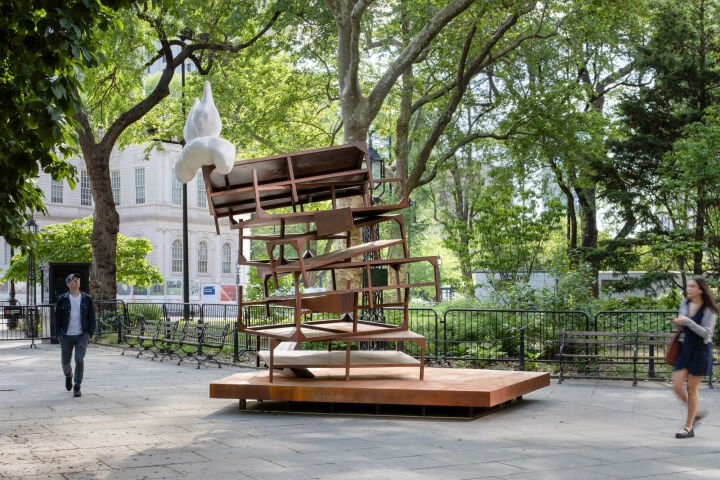
© Phyllida Barlow. Courtesy Hauser & Wirth. Photo: Nicholas Knight, courtesy Public Art Fund, NY. Artwork a part of Phyllida Barlow: PRANK, presented by Public Art Fund in City Hall Park, New York City, June 6, 2023–November 26, 2023.
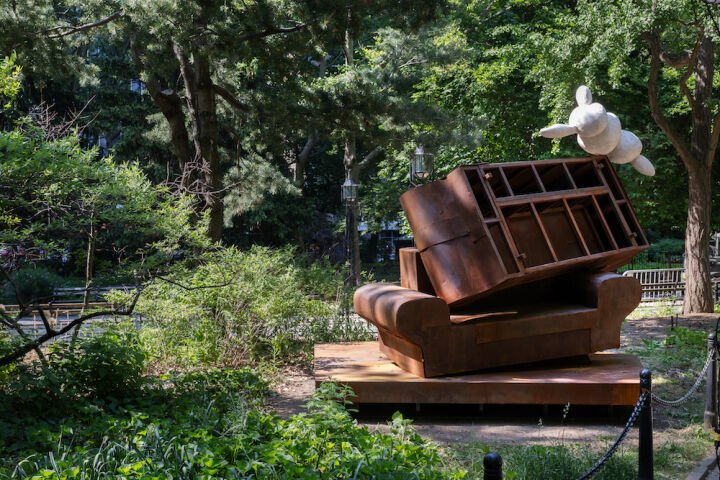
© Phyllida Barlow Courtesy Hauser & Wirth. Photo: Filip Wolak, courtesy Public Art Fund, NY. Artwork a part of Phyllida Barlow: PRANK, presented by Public Art Fund in City Hall Park, New York City, June 6, 2023–November 26, 2023.
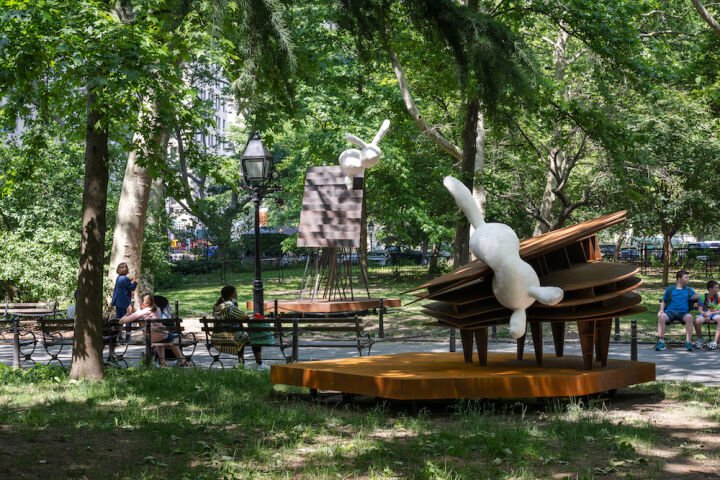
© Phyllida Barlow Courtesy Hauser & Wirth. Photo: Filip Wolak, courtesy Public Art Fund, NY. Artwork a part of Phyllida Barlow: PRANK, presented by Public Art Fund in City Hall Park, New York City, June 6, 2023–November 26, 2023.
- Nairy Baghramian | Scratching the Back, New York City, New York, USA
Nairy Baghramian’s Scratching the Back continues the great series of reimagining of the four façade niches of the frieze of the Metropolitan Museum, looking out toward Fifth Avenue and presenting passersby with new interpretations of what that traditional frieze location could be in our contemporary moment.
Baghramian’s outdoor sculpture has already looked incredible and alive—sometimes serene, other times monstrous—when I’ve seen it rolling down a slope alongside the Walker Art Center in Minneapolis; at the crest of a snowy hill at the Clark in Williamstown, Massachusetts; and gripping two flanking city walls outside the Venice Biennale. Now, Baghramian has used bold combinations of coloured planes and lopsided geometric shapes to great effect against the sandy stone façade of New York City’s storied museum, creating a viewing experience that gives readily to viewers passing by on the east side of Fifth, observing the four sculptures together, or climbing the steps to get close, taking in the sculptures’ pebbled surfaces and smooth lines of piping.
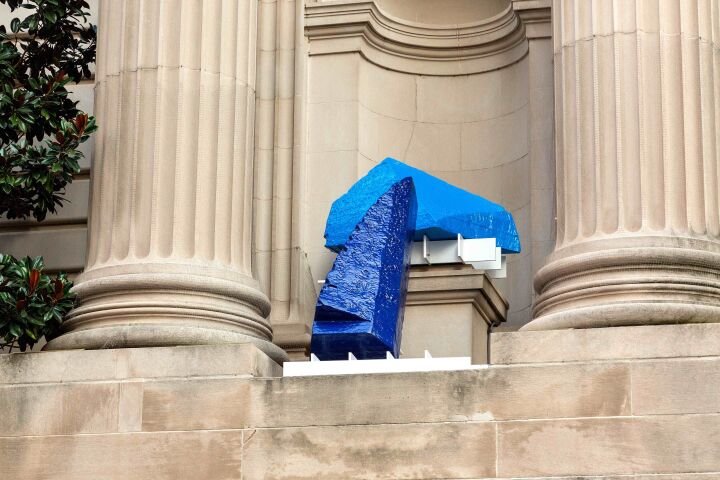
Courtesy the artist, kurimanzutto, and Marian Goodman Gallery. Image credit: The Metropolitan Museum of Art, Photo by Bruce Schwarz.
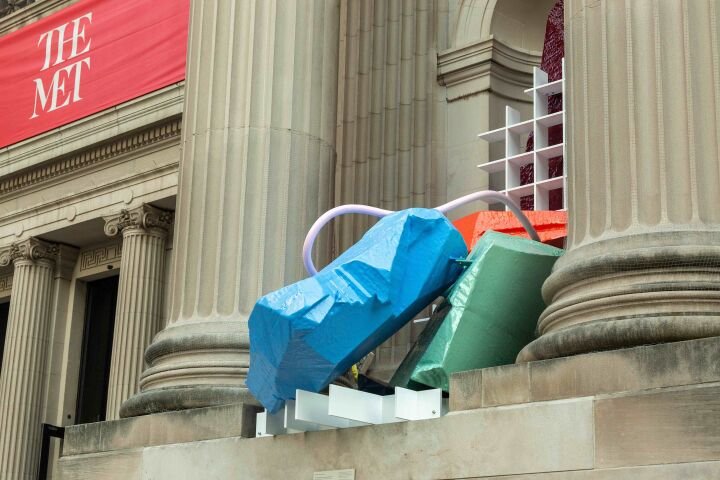
Courtesy the artist, kurimanzutto, and Marian Goodman Gallery. Image credit: The Metropolitan Museum of Art, Photo by Bruce Schwarz.
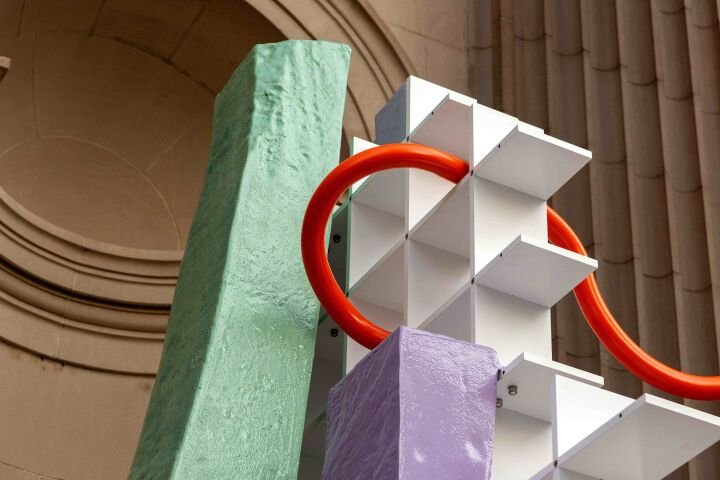
Courtesy the artist, kurimanzutto, and Marian Goodman Gallery. Image credit: The Metropolitan Museum of Art, Photo by Bruce Schwarz.
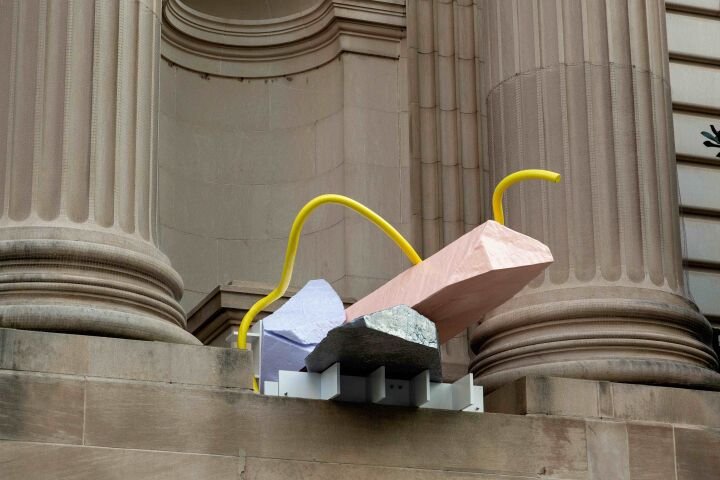
Courtesy the artist, kurimanzutto, and Marian Goodman Gallery. Image credit: The Metropolitan Museum of Art, Photo by Bruce Schwarz.
Nathan Pōhio
- Ibrahim Mahama | TRANSFER(S), Osnabrueck, Germany
Ibrahim Mahama was born in Tamale, Ghana and worked in the capital, Accra; he studied at the University of Science and Technology in Kumasi, where he gained his Bachelor’s, MFA and Ph.D.
In his practice as an artist, Mahama reclaims discarded materials, such as industrial furnishings, disused airplanes, and jute sack cloth, to create monumental, site-specific works of art.
Coming to international recognition as part of All the Worlds Future’s, curated by Okwui Enwezor in 2015 for the 56th Venice Biennale, Mahama’s large scale work in jute had immediate impact. As a base material, jute carries colonial histories for many indigenous communities where natural resources such as coca, like sugar, and rubber came under the imperialist and capitalist mechanism and the communities around these ‘resources’ were forever impacted upon. Through his use of the humble jute sack, and the many hands that engage in adorning and joining these sacks, Mahama deconstructs the architecture of western colonial and economic systems.
Through reclaiming and repurposing materials, such as jute, to express the relentlessness and desperation of imperialist and capitalist agendas, Mahama opens a discourse of a restorative nature. The participatory institutions of Europe, such as the Kunsthalle Osnabrück, Germany appear transformed through this experience, with any consistency to be seen over time. A considerable achievement for any artist, Mahama appears to continue a route of self-determination, realising further socio-political and economic potential for his local community whilst working alongside his fellow artists and arts community practitioners across Africa.
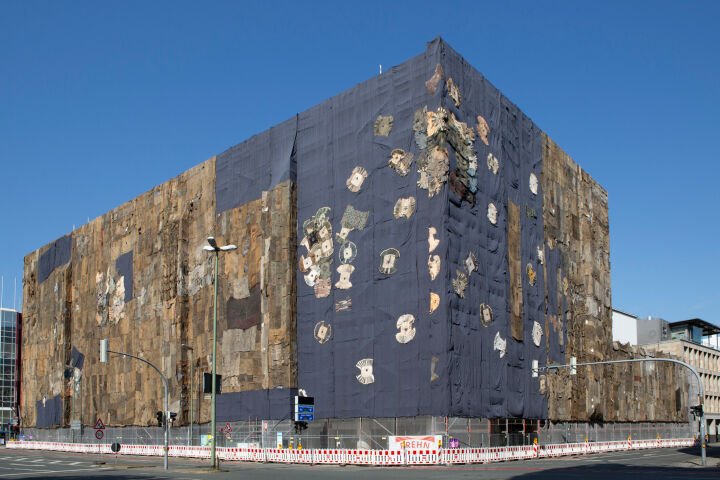
Ibrahim Mahama, “TRANSFER(S)”, installation view, wrapping of former Galeria Kaufhof building in Osnabrück, 2023. Courtesy IbrahimMahama and Kunsthalle Osnabrück. Photo: Lucie Marsmann.
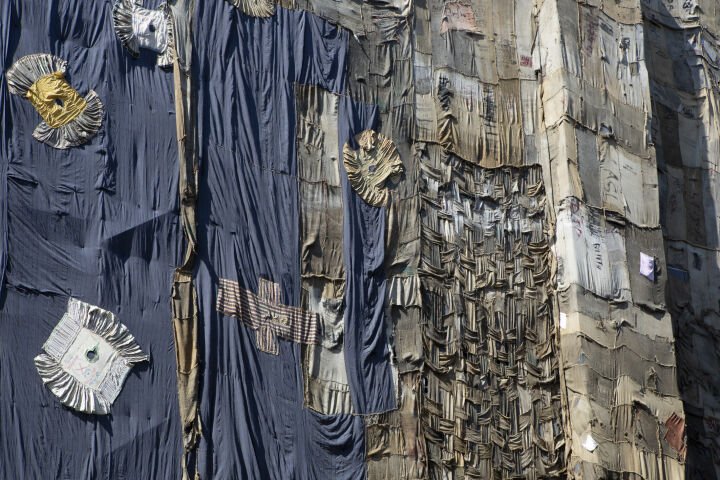
Ibrahim Mahama, “TRANSFER(S)”, installation view, wrapping of former Galeria Kaufhof building in Osnabrück, 2023. Courtesy Ibrahim Mahama and Kunsthalle Osnabrück. Photo: Lucie Marsmann.
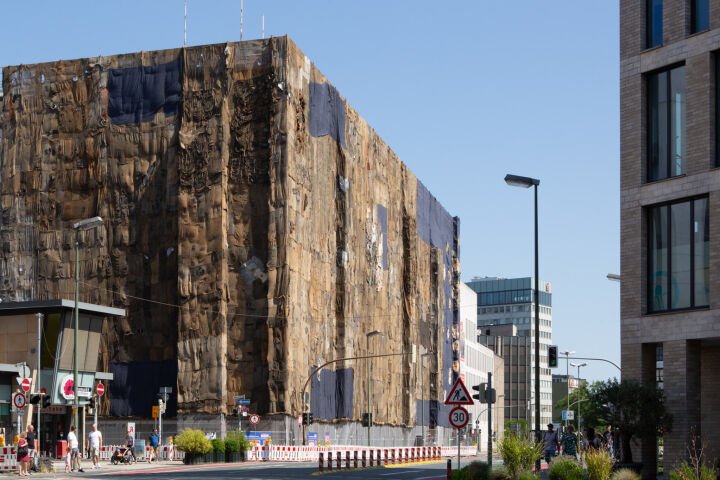
Ibrahim Mahama, “TRANSFER(S)”, installation view, wrapping of former Galeria Kaufhof building in Osnabrück, 2023. Courtesy Ibrahim Mahama and Kunsthalle Osnabrück. Photo: Lucie Marsmann.
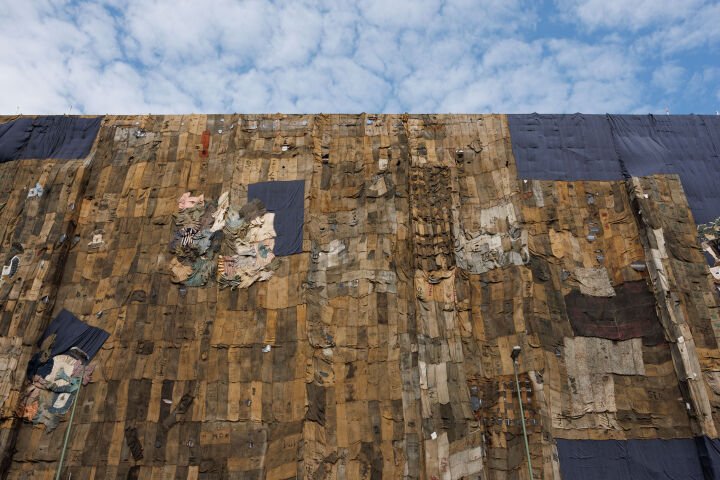
Ibrahim Mahama, “TRANSFER(S)”, installation view, wrapping of former Galeria Kaufhof building in Osnabrück, 2023. Courtesy Ibrahim Mahama and Kunsthalle Osnabrück. Photo: Lucie Marsmann.
- Eddie Clemens | Cognitive Reorientation, Ōtautahi Christchurch, Aotearoa New Zealand
Born in 1977, Eddie Clemens grew up in Rotorua, a territory of great natural beauty and cultural and artistic integrity of Te Arawa, the indigenous nation of that territory.
During the 1830’s Māori realised the potential of natural resources such as Lake Rotomahana where Te Otukapuarangi, (the Fountain of the Clouded Sky) and Te Tarata, (the Tattooed Rock), the largest silica sinter deposits on earth. Considered the eighth wonder of the world and commonly known as The Pink and White Terraces. In 1886, the terraces were buried by the eruption of Mt Tarawera.
Rotorua maintained tourism as the years passed; international trends in tourism entered the local vernacular, and the family show and the spectacle came into play.
As a child of the late 1970s and early 1980s, popular culture and the familiarity of spectacle might account for the stylish, distinctly strange and at once humorous characteristics consistent in Clemens’ practice as an artist. Cognitive Reorientation, 2022 draws inspiration from a Danish TV police drama Forbrydelsen (The Killing) as a jumping-off point. The work deconstructs the production of an early scene in the first episode from the first series where a car is pulled from a river, a classic trope of Hollywood Film Noir such as The Big Sleep, 1946 and Psycho, 1960.
Clemens plays with the artificiality of cinema, rearranging the elements of a murderous scene, to result in a car suspended six members into the air, pouring water. Clemens work reminds us of “the imperfections and fallibility of memory” according to curator Jamie Hanton. Just as disaster struck Rotorua, a considerable about of the Ōtautahi city centre and outlining communities were destroyed following the 2010-11 earthquakes, leaving it up to the memory of its citizens to recall how the city once appeared whilst negotiating the ever-changing landscape since.
Clemens’ work satisfied a much-needed scratch for the citizens of the city in recovery, and his work was quickly enamoured and embraced as it utilised an otherwise abandoned site to become a thing of intelligence, style, and great effort to realise, plus it was dead funny.
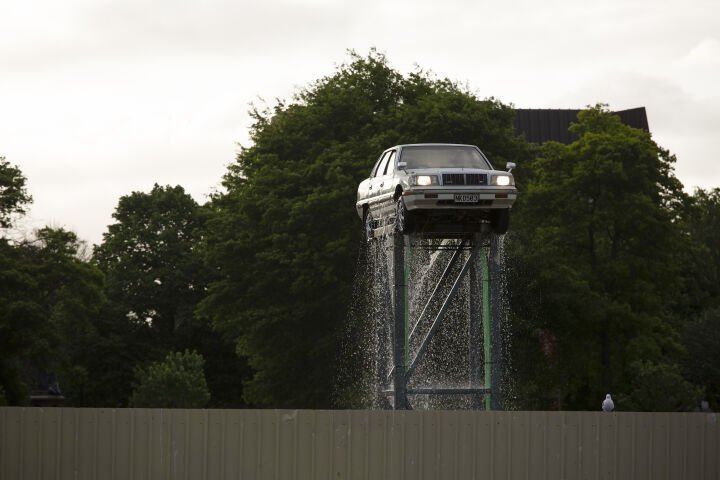
Photo by Heather Milne and courtesy of the artist and Scape Public Art.
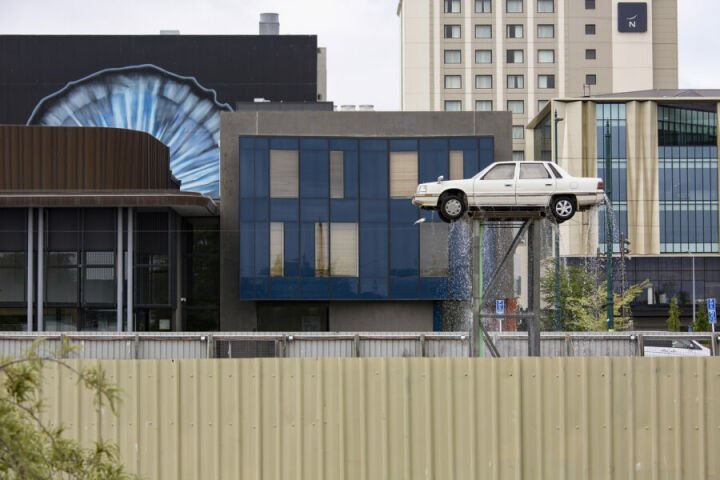
Photo by Heather Milne and courtesy of the artist and Scape Public Art.
Natasha Smith
- Megan Cope | Whispers, Sydney, NSW, Australia
Megan Cope’s public art installation entitled Whispers was unveiled in September of this year at the Sydney Opera House and was commissioned as part of the Opera House’s 50th Birthday Festival.
More than 85,000 collected oyster shells were collated through a year-long process of community workshops hosted on-site at the Opera House Forecourt, in community centres in Sydney and at the artist’s studio in Brisbane, breathing life into this incredibly site-specific, poignant, and lovingly crafted work.
The installation consists of three large-scale elements including two hundred timber poles encrusted with oysters at the Northern Boardwalk, a 14m wall of oyster shells along the western side of the Opera House under the Monumental Steps and traversing the Upper Podium, and a large midden mound sited in front of Bennelong Restaurant.
I nominated this work for its striking gravitas, its ability to stand its ground against the backdrop of the great Opera House architecture, its acknowledgement of First Nations history on this site, its ability to connect community and its potential to educate visitors about Country and how we engage with it.
As Cope states in her own words ‘’All the works are informed by, and trace, six years of research into the history of and cultural relationship to Kinyingarra, from the vast reef constructions made by our Indigenous ancestors to the early lime-burning industries to the potential extinction of oyster reefs and impact of climate change. In the process they ask questions about how art and culture can heal Saltwater Country as well as our current relationship with environment.”
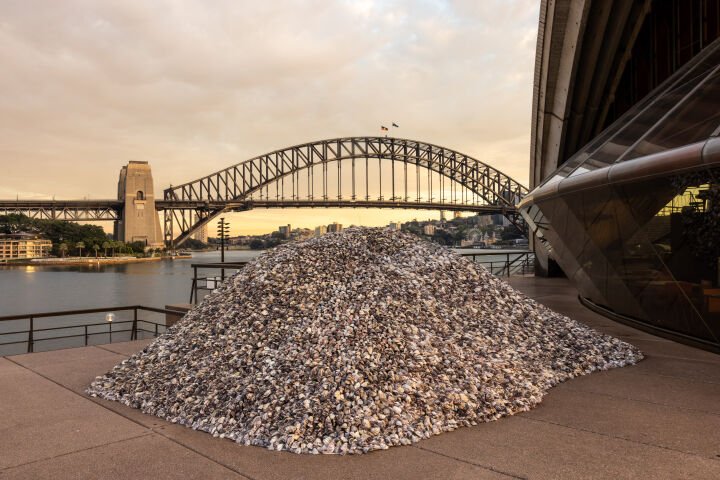
Courtesy of the artist and Sydney Opera House. Photo by Daniel Boud.
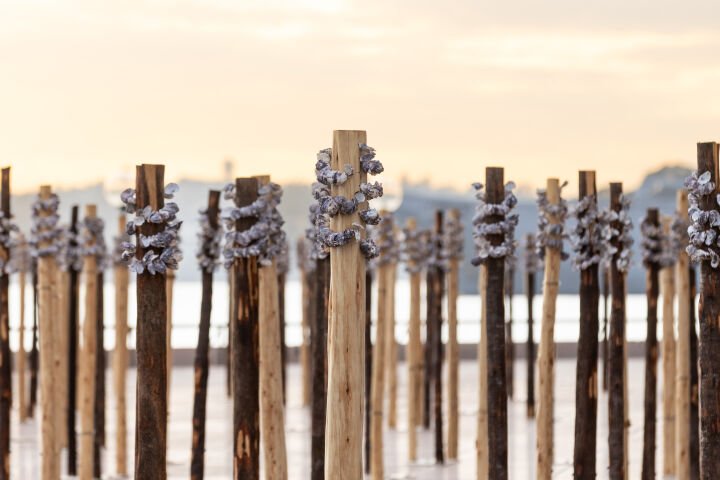
Courtesy of the artist and Sydney Opera House. Photo by Daniel Boud.
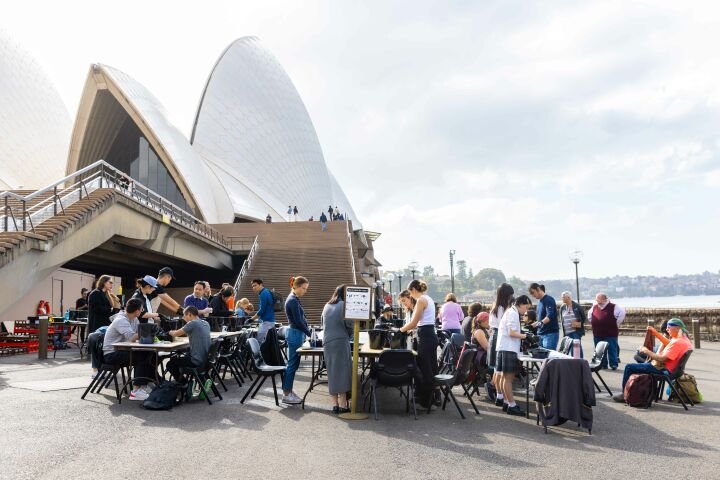
'Scrub Club' shell cleaning workshop on the forecourt of Sydney Opera House. Courtesy of the artist and Sydney Opera House.
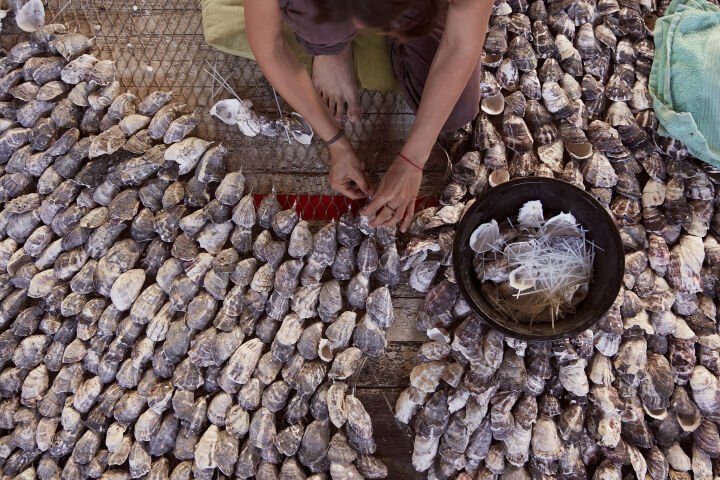
Process shots at Addison Road Community Centre, Photo by Zan Wimberley.
Anna Bellotti
- Brook Andrew | burbangbuwanha winha-nga-nha (Returned Ceremony of Memory), Sharjah, UAE
Brook Andrew’s burbangbuwanha winha-nga-nha (Returned Ceremony of Memory) was commissioned and exhibited as part of Sharjah Biennale 15: Thinking Historically in the Present, which was conceptualised by Okwui Enwezor prior to his passing, and curated by Hoor Al Qasimi. Exhibited for the duration of the Biennale, from February-June 2023, the work featured a series of totemic sculptural works, activated by poetic performances during the opening week of the Biennale. To realise the performances, Brook Andrew collaborated with First Nations practitioners from Australia, and creatives from Sharjah and Berlin. Artists told the story of the removal and repatriation of cultural objects, embodying characters who appeared originally in Brook Andrew’s play, GABAN.
The resulting outcome epitomised Okwui Enwezor’s disruption of canonised ideas around centres and peripheries, bringing perspectives deliberately obscured to the fore. Drawing universal parallels in experiences of cultural erasure, Brook Andrew resituates cultural and social histories and narratives to catalyse collective reflection and questioning. Dismantling structures which have long dictated social, geographic, and historical dynamics, burbangbuwanha winha-nga-nha (Returned Ceremony of Memory) presents a poignant and assertive challenge to persistent colonial legacies.
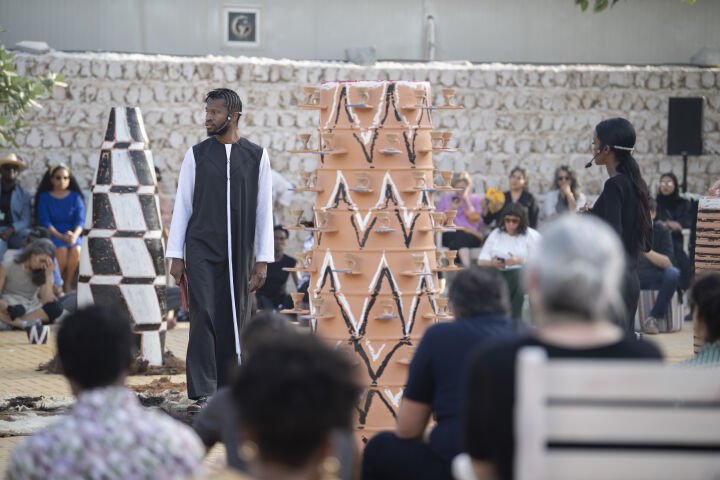
burbang-buwanha winha-nga-nha (returned ceremony of memory), Courtesy of the artist and photo by Motaz Mawid.
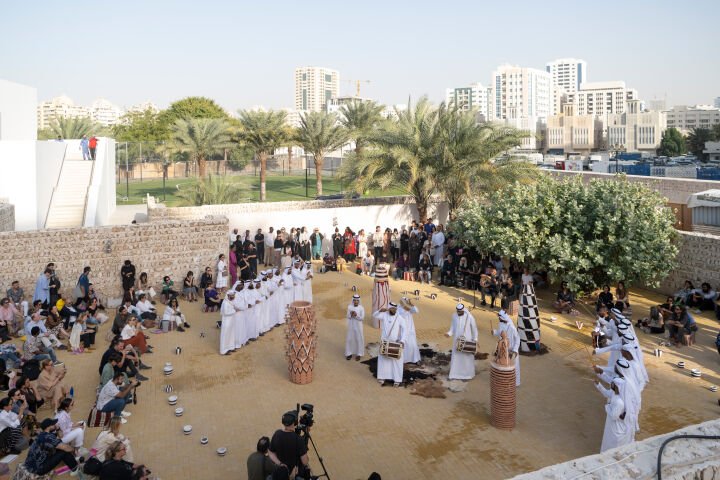
burbang-buwanha winha-nga-nha (returned ceremony of memory), Courtesy of the artist and photo by Shanavas Jamaluddin.
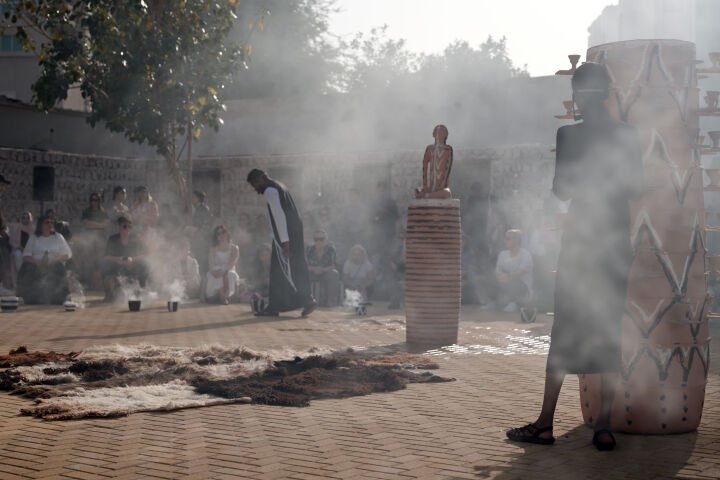
burbang-buwanha winha-nga-nha (returned ceremony of memory), Courtesy of the artist and photo by Brook Andrew.
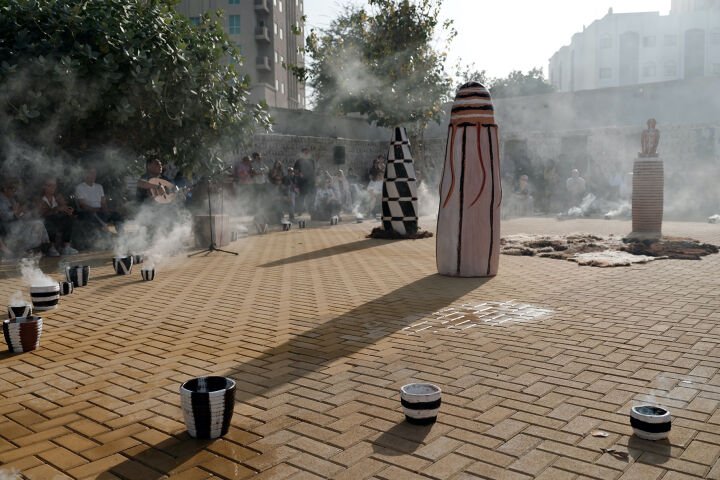
burbang-buwanha winha-nga-nha (returned ceremony of memory), Courtesy of the artist and photo by Brook Andrew.
#Related Articles
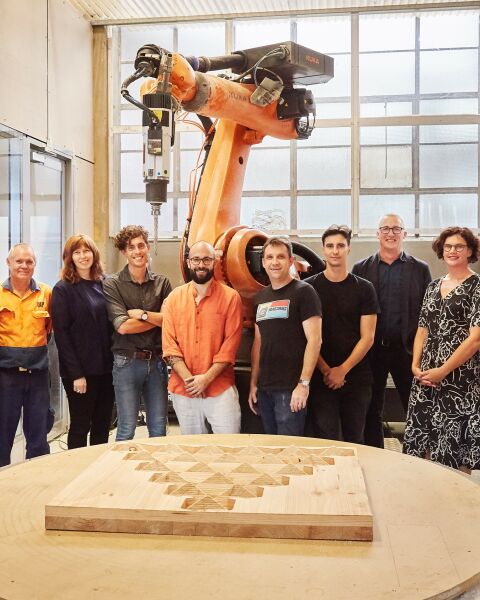
Design Robotics project wins Excellence in Innovation Award
IMCRC congratulates its ‘Design Robotics for Mass Customisation’ team on winning the Cooperative Research Centre Association’s 2020 Award for Excellence in Innovation.

Dick Polich Internship Fund
The new fund will introduce, educate, and empower the next generation of art makers.
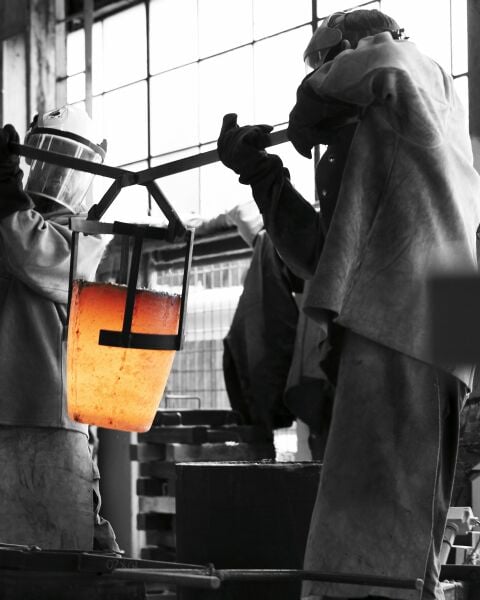
The Best Six Art Fabricators
It is all about executing a vision and art fabricators are the necessary condition to achieve just that.